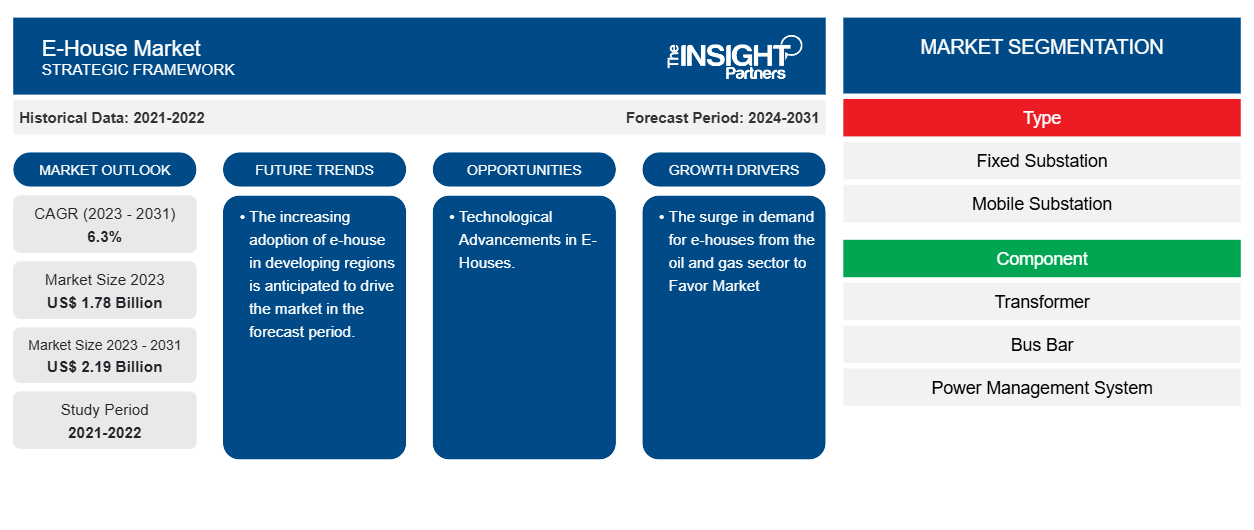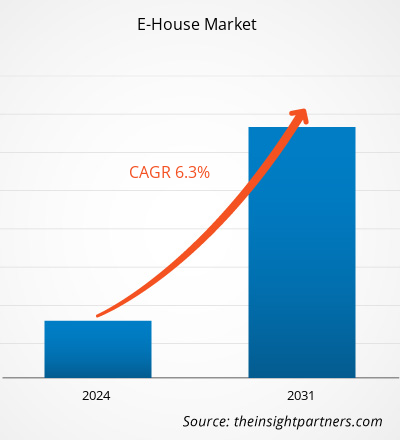The E-house market size is projected to reach US$ 2.91 billion by 2031 from US$ 1.78 billion in 2023. The market is expected to register a CAGR of 6.3% during 2023–2031. The ease of installation, cost-effectiveness, and flexibility of the E-House and the surge in demand for e-houses from the oil and gas sector are likely to be the key drivers and trends of the E-house market.
E-House Market Analysis
The E-house market is experiencing significant growth globally. This growth is attributed to the ease of installation, cost-effectiveness, and flexibility of E-House and the surge in demand for e-houses from the oil and gas sector. Moreover, the adoption of e-house in developing regions and technological advancements is anticipated to hold several opportunities in the coming years.
E-House Market Overview
E-houses are prefabricated substations used as power distribution centers. Such containerized substations provide switchgear rooms as required. For special applications like Datacenters skids can be provided for rapid deployment. Mobile E-Houses are installed on trailers as portable substations.
Customize This Report To Suit Your Requirement
You will get customization on any report - free of charge - including parts of this report, or country-level analysis, Excel Data pack, as well as avail great offers and discounts for start-ups & universities
E-House Market: Strategic Insights

-
Get Top Key Market Trends of this report.This FREE sample will include data analysis, ranging from market trends to estimates and forecasts.
E-House Market Drivers and Opportunities
The surge in demand for e-houses from the oil and gas sector to Favor Market.
Mobile E-Houses are installed on trailers as portable substations. All E-House types can solve various project challenges and support common sustainability goals. E-Houses are deployed in upstream, midstream, and downstream oil and gas facilities. They house equipment for power distribution, control systems, and instrumentation critical to the extraction, processing, and transportation of oil and gas. E-houses are widely used in the oil and gas and mining industry and ever more frequently for the installation of equipment in other sectors. Thus, considering the above parameters, the surge in demand for e-house from the oil and gas sector is driving the market.
Technological Advancements in E-Houses.
The technological advancement in the e-houses is anticipated to drive the market in the coming years. The market has seen significant technological advancements in recent years. These advancements are driven by the need for more efficient, reliable, and adaptable power solutions in a variety of sectors. Various companies offer technologically advanced e-house solutions. For example, Kontrolmatik stays at the forefront of technological advancements in E-House design. The company integrates the latest smart technologies, energy-efficient solutions, and advanced control systems to provide cutting-edge solutions to its clients. Thus, the technology advancements in the e-houses are anticipated to drive market growth in the coming years.
E-House Market Report Segmentation Analysis
Key segments that contributed to the derivation of the e-house market analysis are type, component, and applications.
- Based on type, the e-house market is divided into fixed substations and mobile substations. The fixed substation segment is anticipated to hold a significant market share in the forecast period.
- Based on components, the E-house market is divided into transformers, bus bars, power management systems, variable frequency drives, switchgear, HVAC, and others. The transformer segment is anticipated to hold a significant market share in the forecast period.
- By application, the market is segmented into industrial and utilities. The utilities are anticipated to hold a significant market share in the forecast period.
E-House Market Share Analysis by Geography
The geographic scope of the e-house market report is mainly divided into five regions: North America, Asia Pacific, Europe, Middle East & Africa, and South & Central America.
North America has dominated the e-house market. The North American market is segmented into the US, Canada, and Mexico. High technology adoption trends in various industries in the North American region have fuelled the growth of the e-house market. Factors such as increased adoption of digital tools and high technological spending by government agencies are expected to drive the North American e-house market growth. Moreover, a strong emphasis on research and development in the developed economies of the US and Canada is forcing the North American players to bring technologically advanced solutions into the market. In addition, the US has a large number of e-house market players who have been increasingly focusing on developing innovative solutions. All these factors contribute to the region's growth of the e-house market.
E-House Market Regional Insights
The regional trends and factors influencing the E-House Market throughout the forecast period have been thoroughly explained by the analysts at The Insight Partners. This section also discusses E-House Market segments and geography across North America, Europe, Asia Pacific, Middle East and Africa, and South and Central America.
E-House Market Report Scope
| Report Attribute | Details |
|---|---|
| Market size in 2023 | US$ 1.78 Billion |
| Market Size by 2031 | US$ 2.19 Billion |
| Global CAGR (2023 - 2031) | 6.3% |
| Historical Data | 2021-2022 |
| Forecast period | 2024-2031 |
| Segments Covered |
By Type
|
| Regions and Countries Covered |
North America
|
| Market leaders and key company profiles |
|
E-House Market Players Density: Understanding Its Impact on Business Dynamics
The E-House Market is growing rapidly, driven by increasing end-user demand due to factors such as evolving consumer preferences, technological advancements, and greater awareness of the product's benefits. As demand rises, businesses are expanding their offerings, innovating to meet consumer needs, and capitalizing on emerging trends, which further fuels market growth.

- Get the E-House Market top key players overview
E-House Market News and Recent Developments
The e-house market is evaluated by gathering qualitative and quantitative data post primary and secondary research, which includes important corporate publications, association data, and databases. A few of the developments in the e-house market are listed below:
- Hartek Power joined hands with TP Western Odisha Distribution Limited (TPWODL), a joint venture by TATA Power and Odisha Distribution Limited, for a mandate of two new 33/11 KV E-house containerized type Power Substations worth US$ 2.99 million on a turnkey basis. (Source: Hartek Power Company Website, August 2023)
E-House Market Report Coverage and Deliverables
The “E-House Market Size and Forecast (2021–2031)” report provides a detailed analysis of the market covering below areas:
- E-house market size and forecast at global, regional, and country levels for all the key market segments covered under the scope
- E-house market trends as well as market dynamics such as drivers, restraints, and key opportunities
- Detailed PEST/Porter’s Five Forces and SWOT analysis
- E-house market analysis covering key market trends, global and regional framework, major players, regulations, and recent market developments
- Industry landscape and competition analysis covering market concentration, heat map analysis, prominent players, and recent developments in the e-house market.
- Detailed company profiles
Frequently Asked Questions
Which region dominated the e-house market in 2023?
What are the driving factors impacting the e-house market?
What are the future trends of the e-house market?
Which are the leading players operating in the e-house market?
What would be the estimated value of the e-house market by 2031?
What is the expected CAGR of the e-house market?
- Historical Analysis (2 Years), Base Year, Forecast (7 Years) with CAGR
- PEST and SWOT Analysis
- Market Size Value / Volume - Global, Regional, Country
- Industry and Competitive Landscape
- Excel Dataset
Recent Reports
Testimonials
Reason to Buy
- Informed Decision-Making
- Understanding Market Dynamics
- Competitive Analysis
- Identifying Emerging Markets
- Customer Insights
- Market Forecasts
- Risk Mitigation
- Boosting Operational Efficiency
- Strategic Planning
- Investment Justification
- Tracking Industry Innovations
- Aligning with Regulatory Trends





















 Get Free Sample For
Get Free Sample For